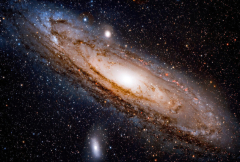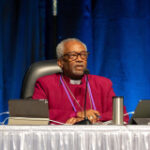(RNS) — When you look into the night sky, the naked eye can only make out 2,500 to 3,000 stars, five planets and maybe one to three galaxies, and that’s assuming ideal atmospheric conditions and the right location. That has been enough in human history to dazzle us with the immensity and wonder of what we can see.
But 100 years ago, astronomer Edwin P. Hubble (1889-1953), working at the Mount Wilson Observatory in California, made a stunning discovery: He calculated that a spiral nebula called Andromeda was about 860,000 light-years away — more than eight times farther than the most distant stars in our galaxy. He came to realize that what we thought was a gas or star cluster in the Milky Way was actually another galaxy, and that the Milky Way was just one of many galaxies in the universe.
Hubble announced his discovery on Dec. 30, 1924. We celebrate that anniversary this week. Hubble went on to discover about 24 more galaxies.
Amazing astronomical discoveries followed. We learned that our universe is much older than we thought and that it is expanding. In 1929, Hubble first measured the expansion rate of the universe. He realized that the farther a galaxy is from us, the faster it appears to be moving away from us. We learned that the universe appears to have had a beginning, an explosion sometimes referred to as “the big bang.”
Our estimate of the number of stars and galaxies has steadily increased. In 1990, NASA launched the famous Hubble Space Telescope, sending it 353 miles out from the Earth. The photos from the Hubble took our breath away. Using its data, astronomers initially estimated that an average galaxy contains about 100 billion stars and that there were about 200 billion galaxies. Now they are thinking this estimate is way too low! This, too, has evoked wonder.

The Carina Nebula is one of the largest and brightest nebulae in the sky, located approximately 7,600 light-years away in the southern constellation Carina. Nebulae are stellar nurseries where stars form. The Carina Nebula is home to many massive stars, several times larger than the sun. (Image credits: NASA, ESA, CSA and STScI)
On Christmas Day 2021, the new James Webb Space Telescope, the most powerful space telescope ever built, was launched. Located 930,000 miles from Earth and designed to detect infrared radiation, it sees more deeply into space than the Hubble. It is now looking back in t





